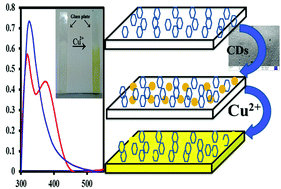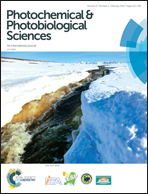Carbon dots as absorbance promoter probes for detection of Cu(ii) ions in aqueous solution: central composite design approach
Abstract
In this work, the use of carbon dots (CDs) as a complexing agent and sensitizer in a polymeric matrix for determination of copper(II) by UV-vis spectroscopy is reported for the first time. A new and highly selective Schiff base, namely, (N′,N′′′E,N′,N′′′E)-N′,N′′′-((((2-hydroxypropane-1,3-diyl)bis(oxy))bis(2,1-phenylene))bis(methan-ylylidene))di(isonicotinohydrazide) (NHBMDI), was also incorporated in the polymeric matrix. For the first time, the membrane composition of the proposed optical sensor including NHBMDI as the ionophore, tetraphenylborate (NaTPB) as the anionic additive, dibutyl phthalate (DBP) as the plasticizer and polyvinyl chloride (PVC) as the immobilizer was optimized through central composite design combined with the desirability function approach (DFA) because this method saves material and time consumption and is therefore cost effective. The synthesized CDs were characterized by transmission electron microscopy (TEM) and scanning electron microscopy (SEM). The fluorescence quantum yield of the synthesized CDs was found to be 6.4% by using quinine sulfate as the reference. The characterization of the prepared membrane sensor was investigated by field emission scanning electron microscope (FE-SEM) and atomic force microscopy (AFM).The response of the optode was based on the strong absorbance of NHBMDI and CDs upon exposure to Cu(II) ions with the maximum wavelength at 371 nm. The proposed sensor exhibited a linear response in the concentration range of 1.2 × 10−6–4.56 × 10−5 mol L−1 with a detection limit of 7.1 × 10−7 mol L−1, which is lower than U.S. Environmental Protection Agency's defined limit (20 μM). Furthermore, the proposed optode displayed good selectivity toward Cu(II) ions in comparison with common coexisting cations with satisfactory repeatability and reproducibility. The sensor was applied successfully for determination of copper(II) ions in water samples.



 Please wait while we load your content...
Please wait while we load your content...